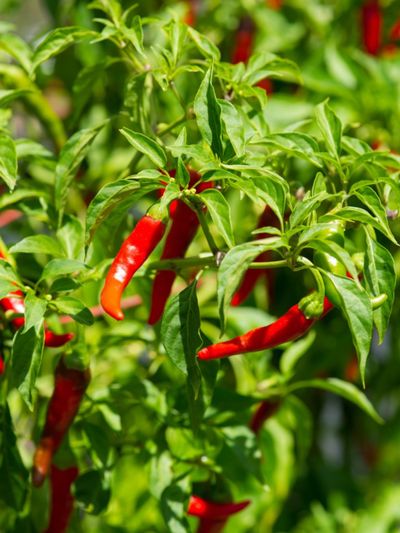Named after the French Guiana city of Cayenne, cayenne pepper plants are related to bell peppers, jalapenos, and other peppers with just a touch more heat than the latter. On the Scoville scale, cayenne pepper is rated at 30,000-50,000 units — spicy, but not so much it will knock your socks off. This Capsicum genus is in the nightshade family of Solanaceae.
How to Grow Cayenne Pepper Plants
Growing cayenne pepper plants requires some heat. Chilies are mostly perennial in their native habitat of sub-tropical and tropical regions. If you live in an area that has a long growing season and a lot of sun, you may directly sow seeds in the garden 10 to 14 days before the last frost date. In temperate areas, chilies are grown as annuals, so when starting cayenne pepper plants from seed, it’s best to do so indoors or in a greenhouse. They are very delicate and react badly to overly hot or cold weather. Sow the seeds in light, well-drained soil medium and keep in a sunny location at a temperature of at least 60 degrees F. (16 C.) until the seeds sprout in 16 to 20 days. Plant the growing cayenne pepper seedlings into flats spaced 2 to 3 inches (5-8 cm.) apart or in individual pots and allow to gradually acclimate or harden to outdoor temperatures. Generally, outdoor transplanting should occur six to eight weeks after the seeds are sown, or after all danger of frost has passed, however, if you choose to transplant before the weather is frost free, it is advisable to protect the plants with row covers, hot caps, and/or transplant the peppers through black plastic. To prepare for transplanting the cayenne pepper plants, amend the soil with fertilizer or organic compound, if need be, avoiding too much nitrogen in an area of full sun to mostly full exposure. Plant your pepper babies 18 to 24 inches (46-61 cm.) apart in a row.
Care of Cayenne Peppers
Moist soil is required in the care of cayenne peppers but take care not to overwater. Saturated soil, or overly dry soil for that matter, may cause the foliage to yellow. Organic mulch or plastic sheeting helps reduce weeding and conserve water, however, do not apply organic mulch until the soil has warmed to 75 degrees F. (24 C.). Cayenne pepper plants may overwinter if protected from frost or moved inside. Prune the plants as needed. Cayenne peppers will be ready to harvest in about 70 to 80 days. When ready, cayenne pepper will be 4 to 6 inches (10-15 cm.) long and easily pull from the stem, although it is really better to snip from the plant so you do not cause any damage. Some fruit will be green, partially green, or colored and should be stored at a temperature of 55 degrees F. (13 C.). Harvesting will be ongoing and continue until the first frost of fall.
Cayenne Pepper Uses
Cayenne pepper uses are unbridled in a number of cuisines from Cajun to Mexican to various Asian foods. Cayenne peppers may be used either as a powder in their whole form in such dishes as Sichuan foods of vinegar based sauces. Fruit from the plant is usually dried and ground or pulped and baked into cakes, which are in turn ground and sifted for use. The fruit of the cayenne pepper is high in vitamin A and also contains vitamins B6, E, and C as well as riboflavin, potassium, and manganese. Cayenne peppers have long been used as an herbal supplement and have been mentioned as far back as the 17th century in the book, “Complete Herbal” by Nicholas Culpeper.
